Rya Formation
The Rya Formation is a geologic formation in Skåne County, southern Sweden. It is Early to early Middle Jurassic (early Sinemurian to late Aalenian) in age. The Rya Formation comprises siltstones, claystones, sandstones, mudstones and rare coal beds. The formation overlies the Höganäs Formation and is overlain by the Vilhelmsfält and Mariedal Formations.
| Rya Formation Stratigraphic range: Early Sinemurian-late Aalenian ~198–171 Ma | |
|---|---|
| Type | Formation |
| Sub-units | Döshult, Pankarp, Katslösa & Rydebäck Members |
| Underlies | Vilhelmsfält & Mariedal Formations |
| Overlies | Höganäs Formation |
| Thickness | Up to 295 m (968 ft) |
| Lithology | |
| Primary | Siltstone, claystone, sandstone, mudstone |
| Other | Coal |
| Location | |
| Coordinates | 56.0°N 12.8°E |
| Approximate paleocoordinates | 45.4°N 16.7°E |
| Region | Skåne County |
| Country | |
| Extent | Höganäs & Øresund Basins |
| Type section | |
| Named for | Rya, Katslösa |
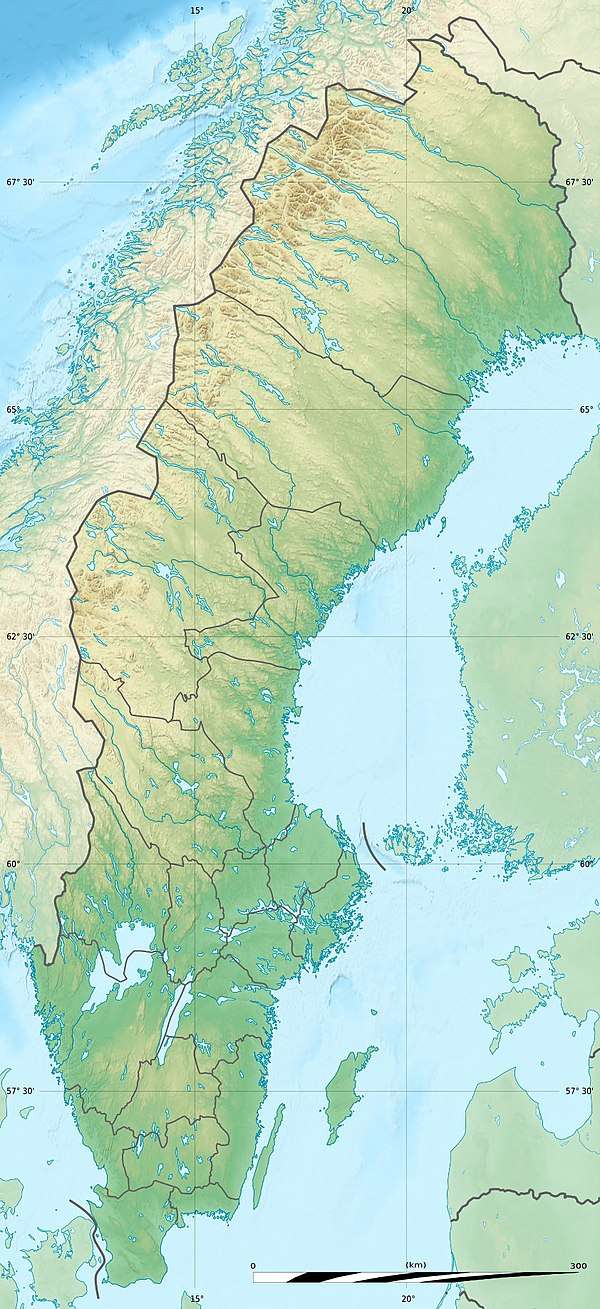 Rya Formation (Sweden) | |
The formation was deposited in the Höganäs and Øresund Basins that formed in the earliest Jurassic as part of the break-up of Pangea. The 295 metres (968 ft) thick formation comprises four members, from base to top the Döshult, Pankarp, Katslösa and Rydebäck Members. The depositional environment of the formation ranges from continental to open marine.
The Rya Formation has provided fossils of a number of sharks, ammonites, bivalves and ichnofossils. Coalified wood occurs as scattered pieces up to 6 centimetres (2.4 in) long and indeterminate belemnites, echinoids, serpulids, ostracods and nodosariid foraminifera were also recorded in the formation. Iron ooids containing erratic boulders, called Geschiebe in German, attributed to the Rya Formation were found in Holstein, northern Germany.
Description
The Rya Formation crops out in Colonus Shale Trough of western Scania.[1] The formation overlies the Höganäs Formation and is overlain by the Vilhelmsfält Formation in the Helsingborg area and by the Mariedal Formation in the area of Landskrona and Kävlinge.[2] The Rya Formation is subdivided, from base to top, into the Döshult, Pankarp, Katslösa and Rydebäck Members. The formation is found in the Ängelholm, Helsingborg, Landskrona and Kävlinge areas. In southwest Skåne, the Rya Formation is missing or only poorly developed.[3] In the Øresund Basin between Sweden and Denmark, the formation is truncated by the Basal Middle Jurassic unconformity.[4]
Erratic boulders, called Geschiebe in German, attributed to the Rya Formation and containing iron ooids were found in Holstein, northern Germany.[5]
Subdivision
- Döshult Member
The early Sinemurian Döshult Member comprises coarse-grained sandstones and siltstones in the lower part, and is dominated by clays and marls rich in marine fossils in the upper part. The member is up to 80 metres (260 ft) thick in the Ängelholm, Helsingborg and Landskrona areas. Presently, the basal part of this member is exposed at three localities in the Helsingborg area. These contain mineralogically and texturally mature, trough cross-bedded sandstones, commonly with herringbone structures showing north and south oriented paleocurrent directions. The occurrence of herringbone structures in well-sorted sand suggests high energy foreshore to subtidal marine depositional conditions for the lower part of the member. In an abandoned quarry in northwest Skåne (Gantofta brickpit in the Helsingborg area, outcrop very limited at present) the upper part of the Döshult Member commences with bioturbated marine nearshore sands, including burrows, as well as abundant marine invertebrate body fossils. This is followed by a bioturbated shelf mudstone with storm-deposited sand and silt intercalations (tempestites). A massive red mudstone with scarce marine body fossils and burrows follows, which is interpreted as having been deposited rapidly, in a low energy but oxidizing environment. The youngest part of the succession comprises siltstones and mudstones, with carbonate-rich beds, deposited in a shallow marine setting.[3] Coaly detritus, muscovite, very small shells and shell fragments, and framboidal pyrite nodules (0.1–0.3 mm in diameter) are characteristic constituents of this member.[6]
- Pankarp Member
The dark mudstones of the Döshult Member are overlain by the Pankarp Member with a sharp conglomeratic boundary.[7] The late Sinemurian Pankarp Member has an estimated thickness of up to 70 metres (230 ft) in the subsurface of the Ängelholm, Helsingborg and Landskrona areas. In the Kävlinge area, the thickness is about 20 metres (66 ft) thick. In westernmost Skåne, the member has been observed in small diameter drill cores. There, the member is subdivided into a lower unit of variegated clays and shales, a middle, poorly sorted silty to sandy unit including a coal bed, and an upper monotonous mudstone unit which is silty and rich in organic matter at the base, and reddish–greenish at the top. In the uppermost part of one core, the Pankarp Member comprises lenticular bedded heteroliths with Planolites burrows.[3]
- Katslösa Member
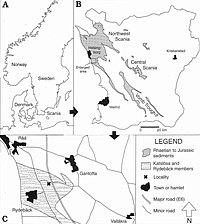
The late Sinemurian to early Pliensbachian Katslösa Member is mainly known from the subsurface in westernmost Skåne, and it has a thickness of 30 to 40 metres (98 to 131 ft) in the Ängelholm, Helsingborg and Landskrona areas. In the Kävlinge area, the thickness is about 75 metres (246 ft). Sedimentological interpretations are mainly based on the results of petrographical studies of museum collections. The Katslösa Member yields a rich marine microfauna and macrofauna, and it is dominated by homogeneous mudstone deposited in a marine low-energy environment. Thin beds of matrix-rich quartz wackes are common. They are typically mineralogically mature but texturally highly immature with abundant angular sand grains. The matrix comprises organic matter, micrite, mica and clay minerals. In thin section, the sandstones show evidence of intense burrowing, which has obliterated depositional structures. Scattered berthierine ooids, as well as authigenic siderite crystals have been observed in the member.[8]
- Rydebäck Member
The late Pliensbachian to late Aalenian Rydebäck Member is up to 70 metres (230 ft) thick in the Ängelholm, Helsingborg and Landskrona areas. It is only known from subsurface material in westernmost Skåne, and sedimentological analysis is based on observations from two wells (Rydebäck–Fortuna-1 and -4). The member comprises a uniform succession of muddy arenites with a rich marine microfauna (mostly foraminifera), and represents deposition in an offshore low-energy environment. The sediments are strongly burrowed, which has caused an effective mixing of sand and mud, resulting in the forming of quartz wackes. The sand is quartz-rich, and grains are typically well rounded. Berthierine ooids are common constituents of the sediment.[8]
Depositional environments
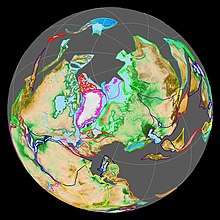
Deposition of the Rya Formation began with nearshore coarse clastics, and continued with offshore mudstones with tempestites (the Döshult Member), followed by offshore muddy sediments with a brief non-marine interval (the Pankarp Member), and ended with deposition of open marine low-energy deposits (Katslösa and Rydebäck Members). The marine Rya Formation shows an overall fining-upwards trend, and an up-section bathymetric deepening of the depositional environment. The depositional environment in western Skåne was either physically protected from the storm energy due to basin topography, or deposition in Skåne took place below storm wavebase. Berthierine ooids occur scattered in the Katslösa Member and are increasingly abundant up-section in the Rydebäck Member. There is a possibility that iron ooid formation was promoted by precipitation of iron and silica from volcanic fluids rising up through the substrate, as has been reported from modern marine sediments offshore Indonesia. This hypothesis has emerged with the publication of age data for the volcanic rocks in Skåne, which now appear to be comparable in age to the prominent iron ooid-bearing deposits, i.e. the Rydebäck Member and the Röddinge Formation.[8]
Age
Based on foraminifers, ammonites and ostracods, the Döshult Member is dated to the early Sinemurian, the Pankarp Member to the late Sinemurian, the Katslösa Member to the late Sinemurian to early Pliensbachian and the Rydebäck Member to the late Pliensbachian to late Aalenian.[3]
The formation is time-equivalent with the Röddinge Formation of the Vomb Trough,[2] and the Bagå Formation of Denmark, with which it shares the Spheripollenites–Leptolepidites and Callialasporites–Perinopollenites Zones.[9][10] The formation also correlates with the Fjerritslev Formation of the Danish Basin,[11] and the Gassum Formation of the Øresund Basin.[12] The storm-dominated, hummocky cross-stratified Hasle Formation on Bornholm is contemporaneous with the muddy Katslösa Member of the Rya Formation.[8]
Basin history
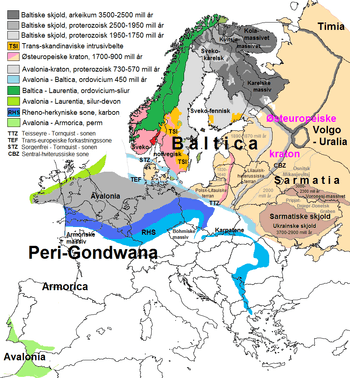
- Basement
The basins where the Rya Formation was deposited form part of the Sorgenfrei-Tornquist Zone (STZ) of the Trans-European Suture Zone, the boundary between Baltica to the northeast and Peri-Gondwana to the southwest. The orogeny was active in the Late Ordovician, or approximately 445 million years ago.
At the Carboniferous-Permian boundary around 300 Ma, the area was influenced by the Skagerrak-Centered Large Igneous Province, another large igneous province stretching across the North Sea, the eponymous Skagerrak between Denmark and Sweden and to the northwest up to northern England and Scotland.
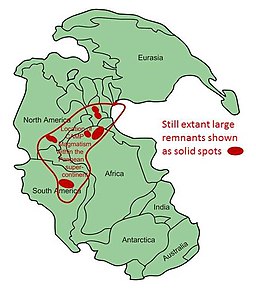
- Break-up of Pangea
The basins of southern Sweden and eastern Denmark were formed during the latest Triassic and earliest Jurassic. During this time the Central Atlantic magmatic province (CAMP), with an estimated 11,000,000 square kilometres (4,200,000 sq mi) the largest igneous province in Earth's history, was formed to the present southwest of the Danish-Swedish realm. In the Skåne area, the Central Skåne Volcanic Province was active during the time of deposition of the Rya Formation, commencing around the Sinemurian-Pliensbachian boundary. The earliest magmatism was partly emplaced into and across pre-existing extensional basin structures.[13] The first and the main volcanic phase of this volcanic province occurred in the Early Jurassic (late Sinemurian to Toarcian) at 191–178 Ma.[14] Analysis of the volcanic rocks produced by this Jurassic volcanism suggests a continental Strombolian-type eruptive character close to the oceans of the Early Jurassic.[15] No correlative pyroclastic beds have yet been identified in sedimentary basins surrounding central Skåne.[16]
- Toarcian
During deposition of the Rydebäck Member, the Toarcian turnover happened. This event at the Pliensbachian-Toarcian boundary characterized by widespread anoxic conditions globally, led to the extinction of various groups of flora and fauna. Taxa inhabiting the upper water column were unaffected by anoxia and included ammonites and belemnites. Epifaunal taxa adapted to low-oxygen conditions, such as the buchiids, posidoniids and inoceramids, flourished in the post-extinction environment during the survival interval.[17]
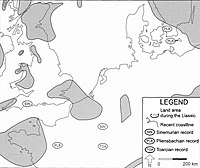
Economic geology
A study on the geothermal potential of reservoirs in the Øresund Basin published in 2018 by Erlström et al. gave results of the formation together with the Gassum and Höganäs Formations, giving the following characteristics of the three Early Jurassic formations:[18]
- Net sand thickness - 60 to 100 metres (200 to 330 ft)
- Porosity - 18 to 34%
- Permeability - 50 to 1500 mD
- Cl− concentration - 120 to 190 gram/liter
- Productivity index - 7.0 m3/hr/bar
A study published in the same year analyzing the CO2 storage potential of the Rya and Höganäs Formations concluded a storage capacity of 543 megatons of carbon dioxide.[19]
The organic content of the Jurassic strata in Skåne is typically dominated by gas-prone kerogen (type III), which is below, or at the onset of, thermal maturity.[16]
Fossil content
The formation has provided fossils of typically marine fauna. With the exception of a continental coal bed, the formation is marine in character. Shark teeth were reported from the Rydebäck Member.[20] Apart from a few teeth of the hybodont Hybodus reticulatus, the shark fauna from the Rya Formation is exclusively neoselachian.[21]
- Fish
| Group | Family | Taxa | Notes | Images |
|---|---|---|---|---|
| Sharks | Hexanchidae | Hexanchidae indet. | [22] | %2C_Agaleus_dorsetensis_(D-G)_and_Paraorthacodus_sp._(H-I).jpg) |
| Agaleidae | Agaleus dorsetensis | |||
| Paleospinacidae | Paraorthacodus sp. | [23] | ||
| Orthacodontidae | Sphenodus sp. | 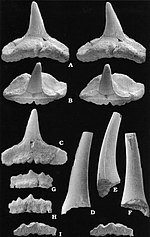 | ||
| Paleospinacidae | Synechodus enniskilleni (G-J) | [24] | _%26_S._enniskilleni_(H-J).jpg) | |
| Synechodus occultidens (A-F) | ||||
| Hybodontidae | Hybodus reticulatus | [23] | ||
- Ammonites
- Bivalves
- Chlamys interpunctata[6]
- Chlamys textoria[6]
- Oxytoma sinemuriensis[6]
- Astarte sp.[6]
- Cardinia sp.[6]
- Entolium sp.[6]
- Homomya sp.[6]
- Leda sp.[6]
- Liogryphaeaarcuata sp.[6]
- Nucula sp.[6]
- Nuculana sp.[6]
- Palaeoneilo sp.[6]
- Pleuromya sp.[6]
- Rollieria sp.[6]
- Ichnofossils
Coalified wood occurs as scattered pieces up to 6 centimetres (2.4 in) long and indeterminate belemnites, echinoids, serpulids, ostracods and nodosariid foraminifera were also recorded in the formation.[6]
See also
- List of fossiliferous stratigraphic units in Sweden
- Kristianstad Basin
- Toarcian formations
- Marne di Monte Serrone, Italy
- Calcare di Sogno, Italy
- Sachrang Formation, Austria
- Saubach Formation, Austria
- Posidonia Shale, Lagerstätte in Germany
- Ciechocinek Formation, Germany and Poland
- Krempachy Marl Formation, Poland and Slovakia
- Lava Formation, Lithuania
References
- Ahlberg et al., 2003, p.528
- Ahlberg et al., 2003, p.530
- Ahlberg et al., 2003, p.533
- Erlström et al., 2018, p.129
- Hinz-Schallreuter & Schallreuter, 2009, p.2
- Frandsen & Surlyk, 2003, p.547
- Frandsen & Surlyk, 2003, p.550
- Ahlberg et al., 2003, p.534
- Nielsen et al., 2003, p.588
- Nielsen et al., 2003, p.590
- Frandsen & Surlyk, 2003, p.543
- Erlström et al., 2018, p.138
- Bryan & Ferrari, 2013, p.1058
- Bergelin, 2009
- Augustsson, 2009
- Ahlberg et al., 2003, p.539
- Harries & Little, 1999
- Erlström et al., 2018, p.139
- Sjöberg, 2018, p.90
- Rya Formation at Fossilworks.org
- Rees, 2000, p.411
- Rees, 2000, p.412
- Rees, 2000, p.416
- Rees, 2000, p.418
- Frandsen & Surlyk, 2003, p.545
- Frandsen & Surlyk, 2003, p.546
Bibliography
- Erlström, M.; L.O. Boldreel; S. Lindström; L. Kristensen; A. Mathiesen; M.S. Andersen; E. Kamla, and L.H. Nielsen. 2018. Stratigraphy and geothermal assessment of Mesozoic sandstone reservoirs in the Øresund Basin – exemplified by well data and seismic profiles. Bulletin of the Geological Society of Denmark 66. 123–149. Accessed 2020-07-09. ISSN 2245-7070
- Sjöberg, Björn. 2018. Strategic Environmental Assessment of the Marine Spatial Plan proposal for Skagerrak and Kattegat, 1–129. Swedish Agency for Marine and Water Management. Accessed 2020-07-09.
- Bryan, S. E., and L. Ferrari. 2013. Large igneous provinces and silicic large igneous provinces: Progress in our understanding over the last 25 years. Geological Society of America Bulletin 125. 1053–1078. Accessed 2020-07-09. doi:10.1130/B30820.1
- Augustsson, Carita. 2009. Lapilli tuff as evidence of Early Jurassic Strombolian-type volcanism in Scania, southern Sweden. GFF 123. 23–28. Accessed 2020-07-09. doi:10.1080/11035890101231023
- Bergelin, Ingemar. 2009. Jurassic volcanism in Skåne, southern Sweden, and its relation to coeval regional and global events. GFF 131. 165–175. Accessed 2020-07-09. doi:10.1080/11035890902851278
- Hinz-Schallreuter, Ingelore, and Roger Schallreuter. 2009. Geschiebe-Oolithe und –Onkolithe III - Mesozoische Oolithe - Oolites and Onkolites as Geschiebes (glacial erratic boulders) III - Mesozoic Oolites. Geschiebekunde aktuell 25. 1–10. Accessed 2020-07-09.
- Ahlberg, Anders; Ulf Sivhed, and Mikael Erlström. 2003. The Jurassic of Skåne, southern Sweden. Geological Survey of Denmark and Greenland Bulletin 1. 527–541. Accessed 2020-07-09.
- Nielsen, Ole B.; Marit-Solveig Seidenkrantz; Niels Abrahamsen; Birthe J. Schmidt; Eva B. Koppelhus; Helle Ravn-Sørensen; Uffe Korsbech, and K. Gynther Nielsen. 2003. An offshore transgressive–regressive mudstone-dominatedsuccession from the Sinemurian of Skåne, Sweden. Geological Survey of Denmark and Greenland Bulletin 1. 543–554. Accessed 2020-07-09.
- Frandsen, Nils, and Finn Surlyk. 2003. The Lower–Middle Jurassic of the Anholt borehole: implications for the geological evolution of the eastern margin of the Danish Basin. Geological Survey of Denmark and Greenland Bulletin 1. 585–609. Accessed 2020-07-09.
- Rees, Jan. 2000. A new Pliensbachian (Early Jurassic) neoselachian shark fauna from southern Sweden. Acta Palaeontologica Polonica 45. 407–424. Accessed 2020-07-09.
- Harries, Peter J., and Crispin T.S. Little. 1999. The early Toarcian (Early Jurassic) and the Cenomanian–Turonian (Late Cretaceous) mass extinctions: similarities and contrasts. Palaeogeography, Palaeoclimatology, Palaeoecology 154. 39–66. doi:10.1016/S0031-0182(99)00086-3 Bibcode: 1999PPP...154...39H
External links
![]()